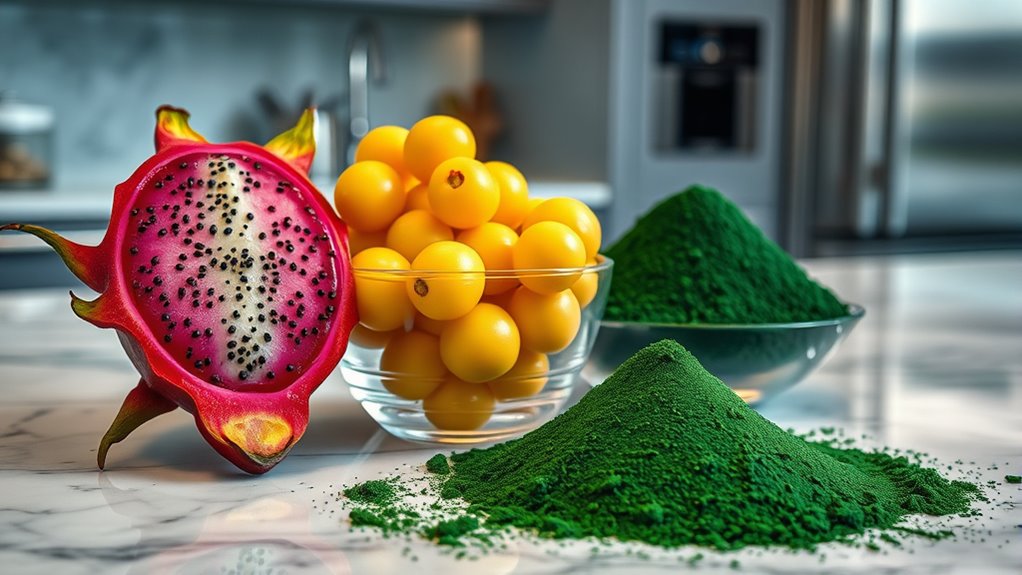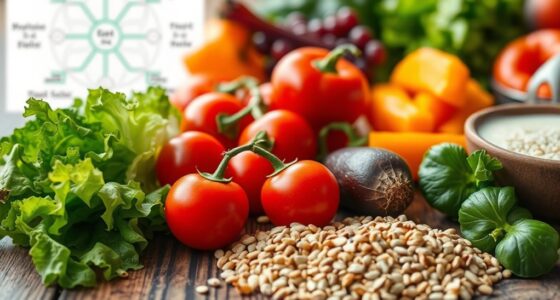In 2025, superfoods are expanding beyond traditional options, featuring algae like spirulina and chlorella, new types of seaweed, and bioengineered crops enriched with extra nutrients. These foods offer benefits like improved energy, immune support, and stress reduction, often infused with adaptogens or probiotics. They’re also eco-friendly and sustainably sourced, helping you meet health and environmental goals. Staying informed on these innovations can help you make smarter, more effective choices for your well-being.
Key Takeaways
- Superfoods in 2025 focus on innovative nutrients like bioengineered grains and algae for enhanced health benefits.
- Plant-based options such as spirulina, chlorella, and new seaweeds are popular for their sustainability and nutrient density.
- Functional superfoods infused with adaptogens, probiotics, and targeted compounds support stress, immunity, and overall wellness.
- Biofortified foods offer increased levels of vitamins, omega-3s, and antioxidants, enabling personalized nutrition strategies.
- Staying informed on these evolving superfoods helps make smarter, health-conscious dietary choices.

As we look ahead to 2025, superfoods continue to evolve, offering new ways to boost your health and energy. This year, you’ll find an array of innovative options that go beyond traditional favorites, bringing fresh nutrients and health benefits right to your plate. These superfoods aren’t just trendy; they’re backed by scientific research, designed to optimize your well-being in practical, tasty ways. Staying informed about these developments can help you make smarter choices, whether you’re looking to improve your energy levels, support your immune system, or maintain a balanced diet.
One of the standout trends in 2025 is the rise of plant-based superfoods that pack a punch with concentrated nutrients. Think of algae varieties like spirulina and chlorella, which you can incorporate into smoothies or snacks. These greens offer high levels of protein, antioxidants, and essential vitamins, making them a powerful addition to your daily routine.
Plant-based superfoods like spirulina and chlorella boost your health with concentrated nutrients and vibrant flavor.
Similarly, new types of seaweed are gaining popularity, thanks to their rich iodine content and unique umami flavor. These options are sustainable, easy to include in meals, and help you meet your nutritional needs without relying on animal sources.
Another exciting development is the emergence of bioengineered superfoods designed to maximize health benefits. These foods often contain enhanced levels of antioxidants, vitamins, or even targeted compounds that support specific health goals. For example, biofortified grains and vegetables are now being developed to deliver higher doses of nutrients like vitamin D, omega-3s, or fiber.
As you shop, you’ll notice more products labeled with these enhanced qualities, making it easier for you to customize your diet to your personal health priorities.
Functional foods with added health benefits are also taking center stage. Think beyond basic nutrition to foods infused with adaptogens, probiotics, or other bioactive compounds. You might find snacks or beverages fortified with ingredients like ashwagandha or turmeric, aimed at reducing stress or inflammation.
These superfoods are designed to fit seamlessly into your busy lifestyle, offering targeted support without complicating your meal prep. As you explore your options, read labels carefully to understand what benefits each product promises, and consider how they can complement your overall wellness plan.
Finally, expect to see a focus on locally sourced, sustainable superfoods that minimize environmental impact. Superfoods of 2025 aim to be eco-friendly and ethically produced, aligning with your values as a conscious consumer.
By choosing these foods, you not only support your health but also contribute to a more sustainable food system. As you incorporate these new superfoods into your diet, remember that variety and balance remain key.
Experiment with different options, listen to your body, and enjoy the journey of discovering what works best for you in this exciting era of nutritional innovation.
Frequently Asked Questions
How Will Superfoods of 2025 Impact Global Food Security?
You might wonder how superfoods of 2025 will influence global food security. As these nutrient-rich foods become more popular, they could improve nutrition in underserved areas, helping fight malnutrition.
However, there’s a chance that increased demand might strain resources, leading to environmental concerns or accessibility issues. If managed wisely, these superfoods could support healthier populations worldwide, but careful planning is crucial to guarantee they benefit everyone equitably.
Are There Any Potential Health Risks Associated With New Superfoods?
You might wonder if new superfoods pose health risks. While they often offer nutritional benefits, some could cause allergic reactions or interact negatively with medications.
It’s smart to stay informed about any potential side effects and consult healthcare professionals before making significant dietary changes.
As these foods evolve, ongoing research helps identify safety concerns, so staying cautious guarantees you enjoy their benefits without risking your health.
How Sustainable Are the Cultivation Practices for These Superfoods?
You might wonder about the sustainability of these superfoods’ cultivation practices. Many growers are adopting eco-friendly methods like regenerative farming and organic practices to reduce environmental impact.
You can support sustainable superfoods by choosing products from farms that prioritize conservation and ethical labor. While some cultivation methods are still evolving, overall, the industry is making strides toward more sustainable practices, ensuring you get healthy foods without harming the planet.
Will Superfoods of 2025 Be Accessible and Affordable Worldwide?
You might wonder if superfoods of 2025 will be accessible and affordable worldwide.
As demand grows and cultivation methods improve, prices could drop, making them more reachable for many.
However, factors like supply chain issues, environmental challenges, and local economies will influence availability.
What Technological Advances Are Enabling the Development of New Superfoods?
Imagine walking into a lab where breakthroughs happen by chance; new superfoods emerge thanks to innovative biotechnology and genetic engineering.
Advances like CRISPR allow you to customize crops for better nutrition and resilience.
Precision agriculture uses AI and sensors to optimize growth conditions, ensuring higher yields.
These technologies enable you to access groundbreaking superfoods more quickly and affordably, transforming your diet with nutrient-rich options that were once science fiction.
Conclusion
As you explore the superfoods of 2025, remember that many claims about their health benefits are still evolving. Some experts believe these foods could revolutionize nutrition, but scientific proof isn’t always concrete. Keep an open mind and stay informed, because what seems like a superfood today might be proven ineffective tomorrow. By staying curious and cautious, you’ll make smarter choices and truly benefit from these emerging nutritional trends.









